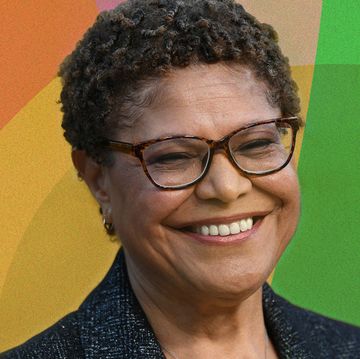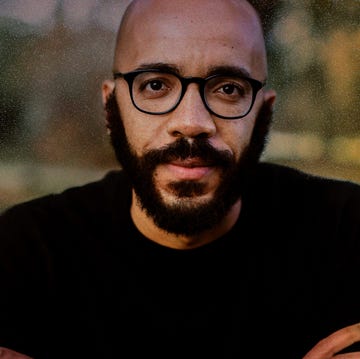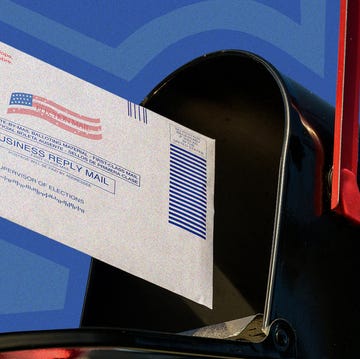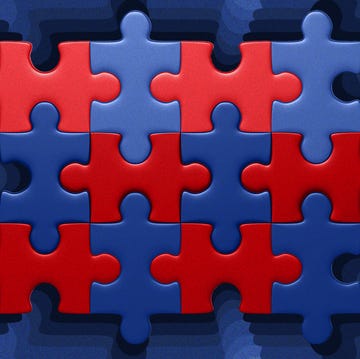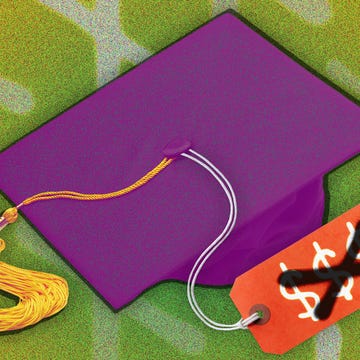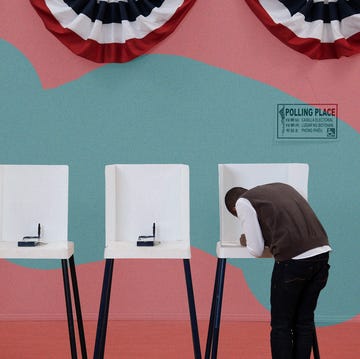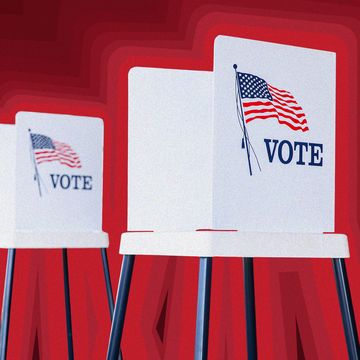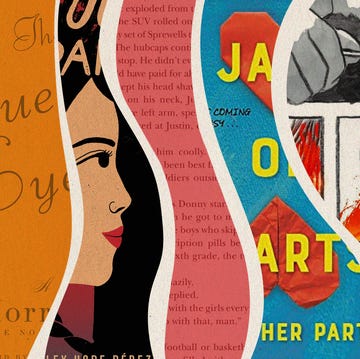On December 14, 2012, Shannon Watts was glued to the television. “I saw the breaking news that there was an active shooter in Newtown, Connecticut, and couldn’t believe 20 children and 6 educators could be slaughtered in the sanctity of an elementary school,” she tells Shondaland. “I was devastated, but woke up the next day enraged. I really did not know what to do with all the anger I felt.” The mother of five, who at the time was on a break from her career as a communications executive, took to the internet, hoping to find an organization that might provide her with the tools and resources to fight for change. “I went online and looked for a group like Mothers Against Drunk Driving (MADD), which had been so influential in my teens in the 80s, but I couldn’t find anything like MADD for guns.”
Though she had only 75 Facebook friends, she decided to start a Facebook page that would offer a safe space to have a conversation about ways to decrease gun violence and push for gun control legislation. Little did she know, the page would become a movement.
“It was like lightning in a bottle,” Watts says. “I had women, mostly moms, from across the country reaching out to me, direct messaging me, finding my information online and calling me, emailing me, texting me, saying, ‘How do I do this where I live?’ None of us knew what that meant at the beginning. I think we all thought, ‘marches and rallies.’ But we quickly realized what it meant was to organize, to create a grassroots army that could go toe-to-toe with the gun lobby. And that’s the genesis of Moms Demand Action.”
Today, Moms Demand Action is the largest grassroots group fighting against gun violence in the United States. With volunteer chapters in every state and millions of supporters, the organization works to pass stronger gun laws and create a culture of responsible gun ownership. The work is crucial, as evident by the recent tragedies in Uvalde, Texas, and Highland Park, Illinois. According to the Gun Violence Archive, in the first 180 days of 2022 alone, there were 297 mass shootings (defined as an incident in which four or more individuals are shot) in the U.S., with 325 people killed and 1,289 people injured.
Watts spoke with Shondaland about her work, the recently passed Bipartisan Safer Communities Act, and why the November 2022 midterm elections are so critical.
SANDRA EBEJER: You always have a wealth of information and data to share when you’re interviewed. When you started Moms Demand Action, what was the learning curve in figuring out where to find this information? How did you even know where to begin?
SHANNON WATTS: Well, certainly for the first few years, it was like drinking from a fire hose every single day. I had a lot to learn about organizing, gun violence, and the policy process. Thankfully, there were so many brilliant volunteers who brought their skill sets to the table. I had one very specific skill set, and that was that I had been a corporate communicator and I knew how to tell a story and build a brand. But there were website developers, lawyers, and organizers who brought their expertise to the table. I never would have been able to fill in those gaps.
We all agreed on some level that we would build the plane as we flew it. We weren’t going to wait until we knew everything there was to know and let the moment pass us by. We were going to jump in, do the work, be willing to fail, and figure it out together as we went along. And I want to emphasize, we were all perfect strangers. I did not know any of these women that I was working with across the country. We were either very lucky or very brilliant that we got this thing off the ground.
SE: Can you talk a bit about the National Rifle Association? Because my understanding is that it wasn’t always as extremist as it is now.
SW: Part of our theory of change was that we wanted to shine a light on how corrupt the gun lobby was, that they clearly weren’t acting like a nonprofit organization, and that their agenda was so extreme and so out of step with mainstream America that the more people knew, the more they would publicly align with us. And we were right. It is clear now that the NRA is hemorrhaging both money and political power 10 years after we started, and that is because we’ve gone after them legally, we’ve shined a light on their misdeeds [including egregious spending of NRA funds for executives’ personal use, as well as lining lawmakers’ pockets], and we’ve attacked their agenda [of pushing guns everywhere, to anyone]. They tried to declare bankruptcy last year and failed. We outspent them in the 2018 election cycle [in lobbying and advertising] for the first time ever. In many ways, they are a paper tiger now.
What we did not account for was that right-wing extremists would embrace the NRA’s agenda so that it didn’t matter if the NRA existed or not. Ultimately, guns have become an organizing principle for extremists and insurrectionists. [Guns are] a way to get people in the door, to recruit new volunteers to their cause, to raise money. It’s a way to excite their base around a whole host of anti-woman, anti-abortion, anti-LGBTQ issues that have nothing to do with guns. It’s really become an ideological war. But the gun lobby itself, the fact that they are so weakened, made it possible for us to pass federal gun legislation [the Bipartisan Safer Communities Act] for the first time in 26 years. We’ve broken the logjam at a federal level because we weakened the NRA, but there’s still a lot of work to do.
SE: According to The Washington Post, since 1966, 98 percent of mass shootings have been carried out by men, and more than 40 percent were men between the ages of 18 and 29. How have gun manufacturers and lobbyists taken advantage of this group?
SW: It’s often online that young men and boys have been exposed to this agenda. Six of the 10 deadliest mass shootings in the last decade have been committed by people under the age of 21. And yet, what do we see the gun lobby trying to do? Lower the age limit to carry a long gun. They want it to be lowered at a federal level. We know easy access to guns for that age group is deadly. About 18 percent of the gun homicides committed in this country are in that age range of 18 to 20, yet they only make up 4 percent of the population. So, it is young white men who are at most risk of committing these crimes when they have easy access to guns.
SE: The Bipartisan Safer Communities Act, which takes a number of steps to reduce gun violence, was passed in June of this year. On the same day, the Supreme Court struck down a New York state law requiring residents to obtain a license if they want to carry a handgun in public. Can you talk about these two very different laws and how they will impact the lives of Americans?
SW: I look at it as two steps forward, one step back. The federal legislation broke a 26-year logjam. It’s the first federal gun-safety legislation that’s passed and been signed into law in 26 years. This is how social movements work. Our goal, as a nonpartisan organization, is to get both political parties on the right side of this issue, and the way you do that is by encouraging lawmakers that when they do the right thing, you’ll have their back. And when they do the wrong thing, you’ll have their job. That’s what we’ve been doing for a decade.
When I started this work, about a quarter of all Democrats in Congress had an A-rating from the NRA; today, none do. That’s because we’ve given them this grassroots army who will have their backs so they can vote with their conscience and carry out the will of their constituents. We were very heartened to see more Republicans voting in favor of gun safety, both in the House and Senate, than ever before. That is a seismic shift in American politics, and it’s really how all social issues work. While this is certainly not everything we wanted, it is lifesaving. It will save thousands of lives, particularly by addressing the boyfriend loophole, which will keep guns away from abusive partners. It is a watershed moment and should be recognized as such.
That said, the Supreme Court ruled with the New York NRA affiliate, which said the permitting system in New York was too strict. They want to make it less rigorous for someone to carry a gun. The good news is that this ruling impacts only six states; five other states besides New York have a similar permitting system, and we’re already working with the leaders in those states to pass gun laws that shore up those permitting systems. In fact, we’re seeing New York put legislation together right now that can serve as a best practice for these other five states. So, the good news is that the Supreme Court did not strike down permitting systems; it just said that New York’s was too rigorous, which we disagree with. Now we can go into state legislatures and strengthen these permitting laws.
SE: You were tweeting recently about companies that have donated to pro-gun politicians. Have you found this type of negative publicity to be effective?
SW: Yes. We realized this was an important lever of power that we could pull because women make about 80 percent of the spending decisions for their families in this country. We started with Starbucks back in 2014. They were allowing open carry inside their stores. This is a place where soccer moms spend a lot of weekends, so we said, “Until you stop your open-carry policy, we’re going to have what we call a Momcott.” We did #SkipStarbucksSaturdays. And it worked. Within months, the CEO of Starbucks said guns are no longer welcome inside our stores.
A few years later, the school shooting in Parkland, [Florida], happened, and we went hard after companies and their gun policies. We were using #GroceriesNotGuns to call out CVS, Walgreens, Walmart, Kroger, and on and on. Over and over again, they would Tweet out and say, “We’ve changed our policy.” We were so successful, there really aren’t any companies that still either align with the NRA or have bad policies. They’re very few and far between.
SE: Many people feel so powerless right now. We call senators and members of Congress, and nothing seems to change. What do you say to those who want change to happen, but feel as though calling doesn’t work?
SW: I can tell you a story that proves just how much it works. Back in 2013, right after the Sandy Hook shooting, there was a bipartisan bill called the Manchin-Toomey bill. Senators Joe Manchin and Pat Toomey worked together to create a bill that would have required a background check on every gun sale, which many states do not require on unlicensed sales. This bill failed by a handful of votes in the Senate. Heidi Heitkamp, a Democratic senator from North Dakota, said the reason she voted against Manchin-Toomey was because she heard from her constituents five to one against the bill.
We vowed right then and there that they will never be able to say that again. We will build a grassroots army so strong that they can say, “We voted against it because we’re gun-lobby shills,” or “we don’t care about our constituents,” but they can never say it was because they didn’t get enough calls. And we have kept that promise.
This round, when the Bipartisan Safer Communities Act came up, Senator Todd Young from Indiana, who is a Republican, said he was going to vote for the bill because he was hearing 10 to one from his constituents in favor of the bill. And that’s because we were able to drive over a million calls to our senators in a very short amount of time. So, that is proof that senators care. All lawmakers care about the incoming calls and emails to their offices, and it does make a difference.
SE: There are so many issues to focus on right now — Roe v. Wade, gun violence, climate change. What is the most important thing people can do right now to deal with these issues?
SW: Getting out the vote is going to be incredibly important this year. We need to register voters, and then we need every registered voter to vote and to know where their candidates stand on these issues.
Senator McConnell said the reason he voted for the Bipartisan Safer Communities Act was because polling showed that swing voters in the suburbs were paying attention and were going to hold lawmakers accountable for inaction. And he’s exactly right. The polling shows that women on both sides of the aisle care very much about the issues of gun safety and abortion, that these swing voters are also gun safety voters, and they are going to vote in November. They will hold a lot of sway over the election outcomes. If I’ve learned anything over the last decade, it’s that an army of angry women is unstoppable. I really think that will be the case in November.
SE: How do you keep your mental health in check doing all of this work day after day?
SW: I think self-care is a really important part of activism. I always say that gun violence prevention is a marathon not a sprint, but it’s also a relay race, and you have to be ready to hand the baton over when you need to prioritize your own self-care or your family’s well-being. I try to meditate twice a day. I try to get outside for hikes or sit in the sun for 30 minutes. I seek inspiration from survivors who do this work every day on top of dealing with trauma and grief. Certainly, if they can do this work, I can too.
SE: The Bipartisan Safer Communities Act was a major accomplishment. What’s next?
SW: We need to vote in November, and then we need to roll up our sleeves and get to work in our city councils, school boards, and statehouses starting in January, when legislative sessions go back into effect.
There’s also a moral imperative right now for women to run for office. We hold less than 10 percent of the 500,000 elected positions in this country. There’s a saying that when you don’t have a seat at the table, you’re probably on the menu. We’ve seen that over and over again, from gun violence prevention to abortion, and on and on. I would encourage everyone out there to think about running. You don’t have to run for president or Congress. You can run for local coroner, you can be on the school board. There’s all kinds of ways that will make a difference.
Moms Demand Action is not just moms and women anymore. We’re non-moms, we’re dads, we’ve got Students Demand Action. There are all different ways to plug in to the work. I would say, find something that you’re passionate about, whether it’s legislative or electoral or cultural, commit to it, and do what you can. Alice Walker says, “Activism is a rent I pay to live on the planet.” And I think that’s right. It’s the rent we pay to live in a democracy.
This interview has been edited for length and clarity.
To learn how to get involved with Moms Demand Action, visit momsdemandaction.org or text ACT to 644-33.
Sandra Ebejer is a New York-based writer who has contributed to The Boston Globe, The Washington Post, Greatist, Flood Magazine, and The Girlfriend from AARP. Find her on Twitter @sebejer.
Get Shondaland directly in your inbox: SUBSCRIBE TODAY


